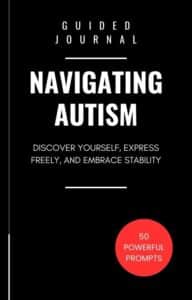These journal prompts are specially designed for those on the autism spectrum to help you explore your thoughts, feelings, and experiences in a way that feels comfortable and enjoyable. Journaling can be a powerful tool for self-expression and personal understanding, and we’ve tailored these prompts to suit a wide range of interests and communication styles.
We understand that everyone experiences the world differently. Some people might enjoy writing about their daily routines or special interests, while others might find it easier to express themselves through drawing or using simple words. Each prompt is crafted to engage your senses, help you reflect on your daily activities, and understand your emotions better. We encourage you to use these journal prompts to celebrate your strengths, work through challenges, and discover new things about yourself and the world around you.
Understanding Autism
What is Autism?
Autism, also known as Autism Spectrum Disorder (ASD), is a developmental condition that affects how a person perceives the world and interacts with others. It’s called a “spectrum” because autism affects different people in different ways. Some might need a lot of help in their daily lives, while others might need less.
Key Features of Autism
- Social Communication and Interaction:
- Challenges: People with autism often find it hard to communicate and interact with others. They might not make eye contact, might not understand gestures like waving goodbye, or might take things said to them very literally.
- Example: If you tell someone with autism, “It’s raining cats and dogs,” they might look up expecting to see animals falling from the sky!
- Repetitive Behaviors and Routines:
- Challenges: A person with autism might repeat certain behaviors and might really need to stick to a routine. Any change can be upsetting.
- Example: If a child with autism eats breakfast at exactly 8:00 AM every day, moving the time to 8:30 AM could really throw them off.
- Sensory Sensitivity:
- Challenges: Individuals with autism might be unusually sensitive to sensory inputs like light, noise, or the texture of clothes.
- Example: Bright lights might seem overwhelming, or they might find certain clothing fabrics uncomfortable.
Causes and Diagnosis
The exact causes of autism are still being researched, but it involves a combination of genetic and environmental factors. There is no single cause that we know of. Doctors diagnose autism by looking at a child’s behavior and development. Early diagnosis can help in managing the condition more effectively through therapies and interventions.
Living with Autism
People with autism see the world in a unique way. They may excel in visual skills, music, math, and art. Some might have a great memory for details. It’s important to remember that autism is a part of who they are, and it does not define their entire identity.
Support and Acceptance
Support for autism comes in many forms—therapy to improve communication skills, educational support tailored to individual needs, and community understanding and acceptance.
Understanding autism helps us appreciate the rich diversity of human experiences. Individuals with autism bring a unique perspective to the world, which enriches our communities. By learning about and accepting autism, we can all help to create a more inclusive society where everyone has the opportunity to thrive.

Journaling: A Tool for Transformation in Autism
What is Journaling?
Journaling is the process of writing down your thoughts, feelings, and experiences on a regular basis. Think of it as a personal space where you can express yourself freely without any judgment. Whether you prefer writing, drawing, or using symbols, your journal is a place to explore your inner world and communicate in ways that feel natural to you.
Why Journal for Autism?
If you or someone you know is on the autism spectrum, journaling can be especially beneficial. It serves as a powerful tool to help manage the unique challenges and harness the distinctive strengths associated with autism. Here’s how journaling can be transformative:
Enhancing Communication
- Self-expression: You might find it easier to express your thoughts and feelings on paper than verbally. Journaling allows you to communicate complex emotions and ideas at your own pace.
- Building Skills: Regular writing helps improve your ability to convey your thoughts clearly, which can translate into better verbal communication skills over time.
Supporting Emotional Regulation
- Understanding Emotions: Sometimes, emotions can feel overwhelming or confusing. Writing them down helps you understand and recognize your emotional patterns.
- Coping Mechanism: A journal can be a safe outlet to express anxiety, frustration, or excitement, helping to manage your emotional response to different situations.
Creating Structure and Predictability
- Routine: Incorporating journaling into your daily routine can provide a predictable and calming element in your day.
- Behavioral Reflection: Writing about your day can help you notice what triggers certain behaviors or feelings and think of strategies to cope with them.
Enhancing Self-Discovery and Personal Growth
- Identifying Strengths and Interests: Journaling can help you discover what you are good at and what you enjoy doing, which can be very empowering.
- Goal Setting: Writing about your aspirations and setting goals can make them feel more attainable and give you a clear direction.
How to Get Started
- Choose Your Medium: Find what works best for you—whether it’s a notebook, a digital app, or an audio recorder.
- Create a Routine: Try to set aside a few minutes each day for journaling. Consistency helps build the habit.
- Be Patient with Yourself: Some days, you might write pages; other days, just a few words. That’s perfectly okay.
- Keep It Personal: Remember, this is your personal space. There’s no right or wrong way to journal.
Journaling is more than just writing—it’s a journey into your mind that helps you understand and connect with yourself better. For someone with autism, this tool can be particularly transformative, helping you navigate the world with greater confidence and clarity. Why not start today and see where your journaling journey takes you? You might be surprised at how much you can learn about yourself and how much you can grow.

Journal Writing Prompts for Individuals with Autism
Download Printable Journal Prompts (PDF) >>
- What is your favorite sound, and why does it make you feel calm?
- List three textures that you enjoy touching. Describe how each one feels.
- Write about a part of your daily routine that you really like.
- What changes in your routine make you feel anxious? How do you cope with them?
- Today, what emotion did you feel most strongly? What caused it?
- Describe a happy memory with a friend or family member.
- Think of a time you solved a problem. What steps did you take?
- What’s your favorite indoor and outdoor activity? Explain why you enjoy them.
- Draw or describe a place where you feel safe and happy.
- What are three things you did well today?
- Reflect on a recent social interaction. What went well, and what was challenging?
- What’s a new word you learned this week? What does it mean?
- When you feel upset, what are some things that help you feel better?
- Describe your perfect day. What activities would you do?
- What are your three favorite hobbies, and why do you enjoy them?
- Write about someone you admire. What qualities do they have that you like?
- If you could invent something to help you every day, what would it be and how would it work?
- Describe a time you felt proud of something you accomplished.
- What is something new you’d like to try, and what steps can you take to try it?
- Reflect on your feelings about a recent event or outing.
- What is your favorite book, movie, or TV show, and what do you love about it?
- Describe a goal you have for this week and how you plan to achieve it.
- Write about a moment when someone made you feel good about yourself.
- If you could talk to any fictional character, who would it be and what would you ask?
- Describe a talent or skill you have. How did you develop it?
- What is your favorite meal to eat, and why do you enjoy it?
- Write about a sound or smell that you don’t like. What makes it unpleasant?
- Describe a tradition in your family. What makes it special?
- What are some things you can do when you feel overwhelmed?
- Think about a recent dream you had. What happened in it?
- What is your favorite time of day? Describe what you see, hear, and feel during that time.
- How do you feel when you try something new?
- List three things that make you unique.
- What is your favorite season, and what activities do you enjoy during that time?
- Write about a challenge you faced and how you overcame it.
- Describe a person who always makes you smile.
- What do you feel most grateful for today?
- If you could change one thing about your day, what would it be?
- Describe a recent accomplishment at school or home.
- Write about a place you’d like to visit. What do you want to do there?
- What are some ways you can show kindness to others?
- How does it feel when your daily routine is interrupted? How do you adapt?
- Describe a hobby you’d like to learn. Why are you interested in it?
- What are three words you would use to describe your family?
- If you could design your own room, what would it include?
- Reflect on the best advice you’ve ever received. Who gave it to you?
- What are your favorite outdoor games to play?
- Describe your feelings about meeting new people.
- What is a skill you’d like to improve? What steps can you take to improve it?
- Write about how you felt today, using colors, shapes, or images to describe your emotions.
This collection is designed to support self-expression and personal growth, tailored specifically for individuals with autism.
Guided Journal for Navigating Autism
50 Writing Prompts to Discover Yourself, Express Freely, and Embrace Stability

Unlock the World of Self-Expression: Step into a space where thoughts and feelings are not just welcomed but celebrated. This guided journal is designed with you in mind, offering a structured path to express what’s inside your mind through words, sketches, or any form that feels right. This guided journal is more than a book—it’s a companion on your journey of self-discovery and expression.
Designed with Sensitivity: Each page reflects an understanding of the sensory sensitivities and communication nuances commonly experienced by individuals with autism. With a clean, clear layout and soothing visuals, this journal invites you to communicate comfortably and without overwhelm.
Prompts That Understand You: Engage with a variety of prompts that are specially crafted to resonate with your experiences. These prompts encourage you to explore everything from daily routines to deep emotions, all at your own pace. They’re not just questions; they’re gateways to deeper self-understanding and meaningful reflection.
Enhance Communication Skills: Regular journaling helps develop your ability to express thoughts and articulate feelings more clearly, which can translate into more confident verbal communication.
Regulate Emotions: The act of writing can be incredibly therapeutic. It provides a private, peaceful outlet for emotions, helping you manage anxiety, excitement, or frustration in a constructive way.
Build a Routine: Incorporating journaling into your daily life can introduce a predictable and calming element, offering stability amidst the chaos of day-to-day life.
Cultivate Personal Growth: Discover personal strengths and areas of interest as you journal. “The guided journal for navigating autism” encourages you to set goals, celebrate achievements, and plan steps toward personal aspirations, fostering a sense of accomplishment and forward movement.
No Rules, Just Write: Whether you fill the pages with bullet points, detailed paragraphs, or quick sketches, your journal is a judgment-free zone. Use it in a way that benefits you the most.
Flexible and Forgiving: Some days you might have a lot to say, while other days might see less ink on the page. This guided journal is here for you always, no pressure, just continuous support.
Thank you for taking the time to explore your thoughts and feelings through “50 Guided Journal Prompts for Individuals with Autism.” We hope that these prompts have provided you with a valuable tool to express yourself and reflect on your experiences. Remember, there is no right or wrong way to use this journal. It is a place for you to be creative, explore your emotions, and communicate in whatever way feels right to you.
As you continue to use these prompts, we hope they become a trusted companion in your journey of self-discovery and understanding. Keep celebrating your unique perspective, and know that every page you fill is a step towards understanding yourself and your world better. Whether you come back to these prompts often or whenever you feel the need, they will always be here to help guide your exploration and support your journey.

